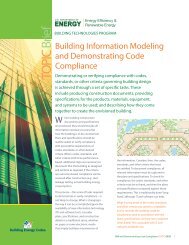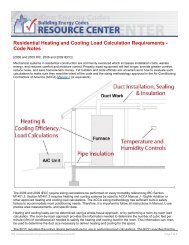Alabama - Building Energy Codes
Alabama - Building Energy Codes
Alabama - Building Energy Codes
Create successful ePaper yourself
Turn your PDF publications into a flip-book with our unique Google optimized e-Paper software.
Table A.8.<br />
Impacts to Consumers’ Cash Flow from Compliance with 2009 IECC Compared to the 2006 IECC<br />
Cost/Benefit Zone 2<br />
Zone 3 –<br />
North of<br />
Warm Humid<br />
Zone 3 –<br />
Warm Humid<br />
State Average<br />
A Down payment and other upfront costs $132 $131 $111 $126<br />
B Annual energy savings (year one) $173 $177 $139 $168<br />
C Annual mortgage increase $72 $71 $60 $68<br />
D<br />
Net annual cost of mortgage interest<br />
deductions, mortgage insurance, and $0 $1 $0 $1<br />
property taxes (year one)<br />
E<br />
=<br />
[B-(C+D)]<br />
Net annual cash flow savings (year one) $101 $105 $79 $99<br />
F<br />
=<br />
[A/E]<br />
Years to positive savings, including upfront<br />
cost impacts<br />
2 2 2 2<br />
Note: Item D includes mortgage interest deductions, mortgage insurance, and property taxes for the first year. Deductions can partially<br />
or completely offset insurance and tax costs. As such, the "net" result appears relatively small or is sometimes even negative.<br />
Table A.9.<br />
Impacts to Consumers’ Cash Flow from Compliance with 2012 IECC Compared to the 2006 IECC<br />
Cost/Benefit Zone 2<br />
Zone 3 –<br />
North of<br />
Warm Humid<br />
Zone 3 –<br />
Warm Humid<br />
State Average<br />
A Down payment and other up-front costs $307 $343 $298 $327<br />
B Annual energy savings (year one) $380 $509 $395 $462<br />
C Annual mortgage increase $166 $186 $161 $177<br />
D<br />
Net annual cost of mortgage interest<br />
deductions, mortgage insurance, and $1 $1 $1 $1<br />
property taxes (year one)<br />
E<br />
=<br />
[B-(C+D)]<br />
Net annual cash flow savings (year one) $213 $322 $233 $284<br />
F<br />
=<br />
[A/E]<br />
Years to positive savings, including upfront<br />
cost impacts<br />
2 2 2 2<br />
Simple Payback<br />
Table A.10 shows the simple payback period, which consists of the construction cost increase divided by firstyear<br />
energy cost savings. This calculation yields the number of years required for the energy cost savings to pay<br />
back the initial investment. Simple payback does not consider financing of the initial costs through a mortgage<br />
or favored tax treatment of mortgages.<br />
As Table A.10 shows, the simple payback period from moving to the 2009 IECC from the 2006 IECC averages 7<br />
years across climate zones. The simple payback for the 2012 IECC is slightly faster, averaging just 6.6 years. The<br />
2012 IECC has significantly higher energy cost savings, resulting in a shorter payback period. Most notably, the<br />
A.8 April 2012
















